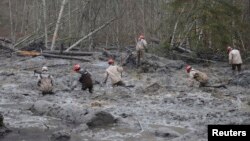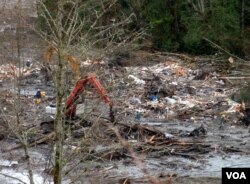OSO, WASHINGTON —
A local fire chief is warning communities around the deadly landslide in northwest Washington state to brace for a jump in the death toll, which currently stands at 17 but with 90 people still unaccounted for. Fresh crews are rotating in to relieve exhausted first responders as the search and recovery mission enters its seventh day. Correspondent Tom Banse had the chance to experience firsthand what’s happening at the place known as “the pile.”
All this week, fire and rescue personnel at the scene of the deadly landslide have expressed a similar sentiment.
“You just can’t fathom what we’re up against out there until you get out there and see the lay of the land," said District Fire Chief Travis Hots. "You can’t look at a photograph and understand it. You can’t even fully understand what we’re up against out there and what has happened even if you watch on TV. It’s unreal.”
I finally got to judge for myself on a carefully controlled media tour to the edge of the landslide.
Steve Mason led the way in his yellow firefighter jacket and battalion chief helmet. Mason took us to an overlook where we could see the mudflow, a vast, lumpy plain that is almost all grey. Water collects in low spots and splintered tree trunks are scattered all over. From this distance, they look like spilled match sticks. Around the edges of this forbidding debris field are signs of homes and structures that are barely recognizable.
“In some cases, we have houses that are more intact than others," Mason said. "Some of them look like they’ve been put in a blender and dropped on the ground.”
The scene reminds me of the aftermath of the 1980 eruption of Mount St. Helens.
“Well, the earth moved. It’s the same type of analogy, I would say on a smaller scale than [Mount St. Helens]," Mason said. "There were homes in the way and the mountain came down on them.”
In the middle distance, searchers and heavy equipment operators work. They stand out in brightly colored outfits - yellow, orange, blue and a lot of red helmets. I notice they move very slowly.
“It’s kind of like forensic digging," Mason explained. "What we’re doing, you have people around who are watching. They look at the area. They bring the machine in. The machine very gingerly picks up small bites of material. Set it off to the side. People go through that material. People look where the machine has just pulled out the material. If it’s OK, the machine goes back and pulls some more material.”
The squish, squish of boots in mud may become one of the signature sounds of this disaster. And yes, it was raining again during our tour. Mason says navigating around “waist-deep” mud presents a constant challenge.
“We’ve had people bring in plywood, cut it into strips, so the workers can get out here, back and forth faster,” Mason said. “We’re building a [street] network out there to get out there.”
It was strangely quiet when I first got out of our van. The highway dead ends at a wall of mud and debris. I could see lots of rescue rigs and yellow back hoes and little bobcat loaders staged there. But none of them were running. I soon realized why.
A group of relatives was there. They’d come to see the place where one or more of their loved ones presumably took their last breaths. Such pauses to give families access for remembrance and communion happen multiple times a day.
It was a somber and powerful moment.
All this week, fire and rescue personnel at the scene of the deadly landslide have expressed a similar sentiment.
“You just can’t fathom what we’re up against out there until you get out there and see the lay of the land," said District Fire Chief Travis Hots. "You can’t look at a photograph and understand it. You can’t even fully understand what we’re up against out there and what has happened even if you watch on TV. It’s unreal.”
I finally got to judge for myself on a carefully controlled media tour to the edge of the landslide.
Steve Mason led the way in his yellow firefighter jacket and battalion chief helmet. Mason took us to an overlook where we could see the mudflow, a vast, lumpy plain that is almost all grey. Water collects in low spots and splintered tree trunks are scattered all over. From this distance, they look like spilled match sticks. Around the edges of this forbidding debris field are signs of homes and structures that are barely recognizable.
“In some cases, we have houses that are more intact than others," Mason said. "Some of them look like they’ve been put in a blender and dropped on the ground.”
The scene reminds me of the aftermath of the 1980 eruption of Mount St. Helens.
“Well, the earth moved. It’s the same type of analogy, I would say on a smaller scale than [Mount St. Helens]," Mason said. "There were homes in the way and the mountain came down on them.”
In the middle distance, searchers and heavy equipment operators work. They stand out in brightly colored outfits - yellow, orange, blue and a lot of red helmets. I notice they move very slowly.
“It’s kind of like forensic digging," Mason explained. "What we’re doing, you have people around who are watching. They look at the area. They bring the machine in. The machine very gingerly picks up small bites of material. Set it off to the side. People go through that material. People look where the machine has just pulled out the material. If it’s OK, the machine goes back and pulls some more material.”
The squish, squish of boots in mud may become one of the signature sounds of this disaster. And yes, it was raining again during our tour. Mason says navigating around “waist-deep” mud presents a constant challenge.
“We’ve had people bring in plywood, cut it into strips, so the workers can get out here, back and forth faster,” Mason said. “We’re building a [street] network out there to get out there.”
It was strangely quiet when I first got out of our van. The highway dead ends at a wall of mud and debris. I could see lots of rescue rigs and yellow back hoes and little bobcat loaders staged there. But none of them were running. I soon realized why.
A group of relatives was there. They’d come to see the place where one or more of their loved ones presumably took their last breaths. Such pauses to give families access for remembrance and communion happen multiple times a day.
It was a somber and powerful moment.









